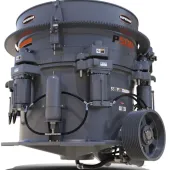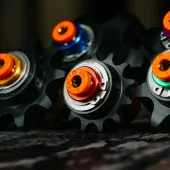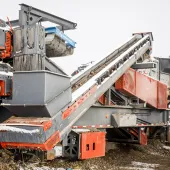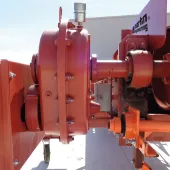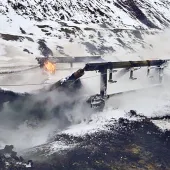Staying on track with Martin Engineering

Company’s latest conveyor belt tracking systems help reduce spillage and potential fire hazard
MARTIN Engineering offer a family of responsive conveyor belt tracking systems that are designed to mitigate misalignment, rather than correcting it after the fact – even on reversing belts.
A mistracking belt can contact the mainframe, seriously damaging both the belt and the structure, resulting in excessive spillage and even creating a potential fire hazard.
Utilizing innovative multiple-pivot, torque-multiplying technology, the Martin Tracker detects slight misalignments initiated by unbalanced loads and fouled rollers, using the force of the belt to immediately adjust its position and realign the path.
The trackers minimize risk and material loss, decreasing downtime and operating costs by reducing clean-up and equipment damage.
Rollers attached to the end of a sensing arm assembly ride both sides of the belt edge, detecting even slight variations in the belt path. Employing the force of the wandering belt, the arms automatically position a steering idler in the opposite direction of the misalignment.
Transferring the motion to the steering idler through a unique parallel linkage requires less force to initiate the correction, so fine-tuning of the path can be continuous, active and precise.
According to Dan Marshall, product engineer for Martin Engineering, the biggest issue from a mistracking belt is spillage. ‘If the belt is out of place, it’s not handling the load properly, and that will cause material to leave the belt,’ he explained.
‘The build-up can be extremely rapid, especially from a high-speed conveyor, which drives up expenses due to wasted material and added clean-up. It also introduces the inherent risk which is always present when people are working around a moving conveyor.’
He continued: ‘The other big issue is having an instantaneously responsive tracking system, because a misaligned belt can quickly drift over into the conveyor frame and begin abrading the belt and the structure. If this isn’t caught right away, great lengths of valuable belting can be destroyed, and the structural steel itself can be damaged. In some cases, this has caused fires or compromised the integrity of the structure.’
The multi-pivot design of the Martin system corrects many of the problems exhibited by current trainer systems on the market, such as belt switches, vertical guides, v-idlers, crowned pulleys and sensing-roll trainers.
According to Martin Engineering, some correction systems have a tendency to overcompensate, requiring a safety tether or lead line to catch the device when the force of the misalignment detaches the unit from the mainframe. Moreover, many of these systems correct mistracking after it has occurred, rather than constantly working to prevent it.
By continuously mitigating tracking issues rather than reacting to them, the risk of failure is significantly reduced.
Utilizing a troughed idler support system on the carrying side of the conveyor to retain the proper angle and keep the load centred, Martin Engineering’s Belt Tracker upper unit employs guide rolls that are set 6mm from the belt for high precision when making opposing adjustments to the idlers.
Typically positioned shortly after the loading zone and just before the discharge pulley, extra trackers can be placed along the belt path, depending on the length of the conveyor and the tendency for cargo to shift. Belt Tracker lower units are hung from the mainframe under the return belt every 21–50m and use a single flat rubber idler to bring the belt back into alignment.
Upper and lower trackers are available in three models: standard-duty, heavy-duty (HD) and extra heavy-duty (XHD). The standard-duty model is designed for typical industrial material-handling conditions, and can accommodate belt thicknesses of 16mm and under, widths from 500mm to 1,600mm, and speeds up to 3.5 metres/s.
Engineered to withstand the stress associated with wider, thicker belts moving at higher speeds and carrying heavier loads, the Tracker HD serves belts as thick as 28.5mm), widths of 800–2,000mm), and speeds as fast as 4 metres/s. The Tracker XHD handles all other belt speeds and thicknesses for belts up to 2,700mm in width.
Reversing belts are a particularly difficult issue for belt tracking. They have some unique issues, because what works for conventional belt-training devices to centralize a belt’s path when it runs in one direction, will have the opposite effect when the belt direction is reversed.
Martin Engineering’s designers determined that the same multiple-pivot, torque-multiplying technology as the upper and lower tracker could be utilized for a reversing belt by adding a circular forked paddle or stainless steel lamella that detects the belt direction.
Utilizing two sets of sensing-arm assemblies on either side of the unit to accommodate belt widths of 500–2,200mm, the arms are engaged based upon the direction of the spinning paddle.
The reversing belt Tracker is also available with an air-operated cylinder in place of the paddle wheel, to activate the sensing rollers on the end of the unit when belt direction changes.
To keep the belt centred in a reversing conveyor’s loading zones, Martin Engineering recommend the installation of one reversing tracker at the entry and exit of each loading point.



